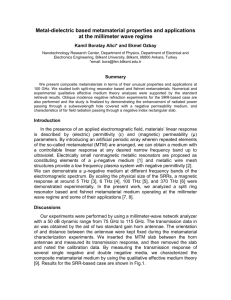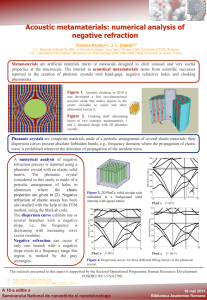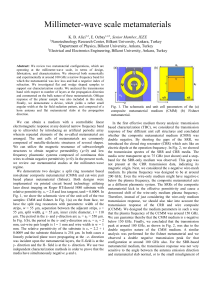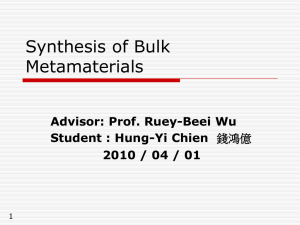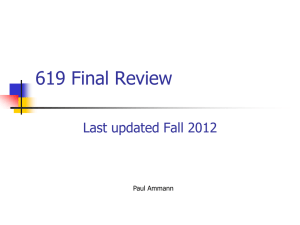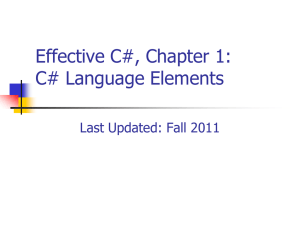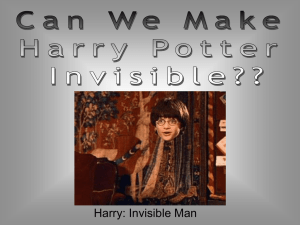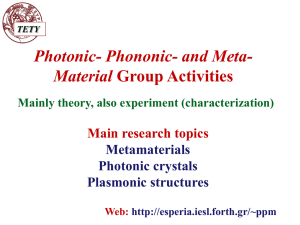Metamaterials
advertisement
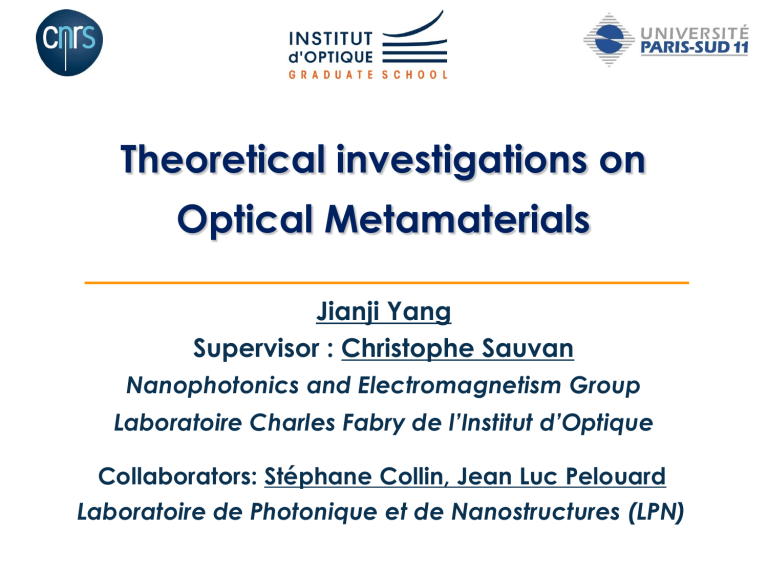
Theoretical investigations on Optical Metamaterials Jianji Yang Supervisor : Christophe Sauvan Nanophotonics and Electromagnetism Group Laboratoire Charles Fabry de l’Institut d’Optique Collaborators: Stéphane Collin, Jean Luc Pelouard Laboratoire de Photonique et de Nanostructures (LPN) Metamaterials (MMs) MMs: Engineered materials possessing properties that are not available in nature, especially negative permeability and negative refractive index. Potential applications : Imaging, Invisibility Cloaking, Sensors , Photon Management, Nonlinear Optics, Antennas, Wave Absorber… Example: Negative Index “Perfect” Lens J. Pendry, " Negative Refraction Makes a Perfect Lens ", Phys. Rev. Lett. 85, 3966 (2000). 2 Concept of Effective Parameters Effective Parameters: It is a significant challenge to homogenize metamaterials, i.e. to determine the effective material parameters. Crucial Parameters: effective refractive index neff , effective permittivity ɛeff and effective permittivity µeff … r metamaterial r homogenization neff, ɛeff , µeff ɛeff <0, µeff <0 t neff <0 t 3 Negative index in the microwaves Magnetic Response Split Ring Resonator (SRR) H μeff Electric Response Metallic Wires Collection of SRR forms effective magnetic medium. εm<0 Collection of conducting wires forms an effective metal with a controllable plasma frequency. Fω2 = 1- 2 ω - ω02 + iωΓ Γ: dissipation factor F: fractional factor eff ωP2 = 1- 2 ω ωP: controllable plasma frequency Pendry, J. B., et al., 47, 2075, IEEE Trans. Microw. Theory Tech. (1999) Pendry, J. B., et al., 76, 4773 , Phys. Rev. Lett. (1996) 4 Negative index in the microwaves 5mm Split-ring resonators (SRRs) based metamaterial, functioning in microwave spectrum. R. A. Shelby et al., Vol. 292, pp. 77 - 79, Science (2001). 5 Moving to Optical Spectrum Conceptual Difficulties: high dissipation of metals, saturation of magnetic resonance… Fabrication Difficulties: difficulty of scaling-down and stacking-up… Fishnet Metamaterial 1mm Fishnet metamaterials, functioning in near-infrared spectrum. J. Valentine et al., 455, 376-379, Nature (2008). Current Loop 6 Fishnet: important fundamental mode Prism Measurement Air Fishnet Prism α n<0 measurement Output Beam fundamental Bloch mode Quartz Incident Beam Measurement agrees well with calculated fundamental Bloch mode. J. Valentine et al., 455, 376-379, Nature (2008). 7 Fishnet: important fundamental mode Single Bloch Mode Approximation (SBMA) fundamental Bloch mode mediates the light transport in fishnet metamaterials. r air 0.8 T 0.6 0.4 0.2 SBMA 0 Rigorous 0.8 R 0.6 Fundamental Bloch Mode neff 0.2 Fishnet t 0.4 0 1.4 1.8 2.2 λ (μm) J. Yang et al., Appl. Phys. Lett. 97, 061102 (2010)8 Microscopic Model: basic waveguide modes TE01 Metal layer Dielectric layer gap-SPP TE01 : least attenuated mode of a rectangular hole gap-SPP : least attenuated mode of a planar SPP waveguide J. Yang et al., (submitted) 9 Elementary Scattering Coefficients Incident TE01 Incident gap-SPP ρ α gap-SPP α α τ TE01 tsp rsp α gap-SPP ρ , τ : reflectivity and transmissivity of TE01 rsp , tsp : reflectivity and transmissivity of gap-SPP α : coupling coefficient between gap-SPP and TE01 H.T. Liu and P. Lalanne, 452, 728-731, Nature (2008) 10 Coupled Mode Formalism Am B m Cn Cn+1 Dn Dn+1 Am+1 Bm+1 Am = τAm+1 + ρBm Bm = τBm-1 + ρAm Cn = tspCn+1 + rspDn Dn = tspDn+1 + rspCn + αCn + αDn+1 + αCn + αDn+1 + αBm+1 + αAm + αBm+1 + αAm s Dispersion relation Analytical Model ( )2 ( )2 1 cos (k 0neff a z ) 2( ) 11 Microscopic Model Am B m Cn Cn+1 Dn Dn+1 Am+1 Bm+1 Microscopic model Fishnet mode (exact) 12 Resonance of gap-SPP Gap-SPP mode shows resonance around 2mm, via the coupling with TE01 mode, this resonance influences the light transport significantly. Current Loop 13 Conclusion: We have studied the optical fishnet metamaterials theoretically. In particular we investigate the important fundamental Bloch mode of fishnet structure, and we also formulate the construction of this mode from a relatively microscopic point of view. In the future, we will investigate other types of plasmonic structures, especially some potentially applicable designs. 14 Thank you ! 15
